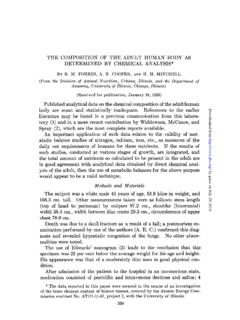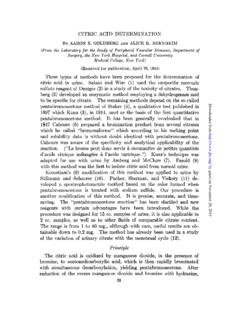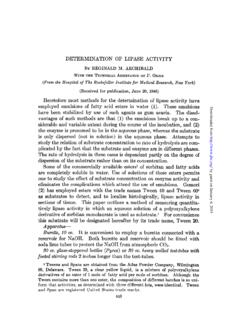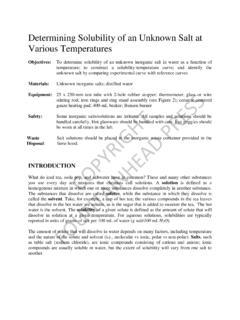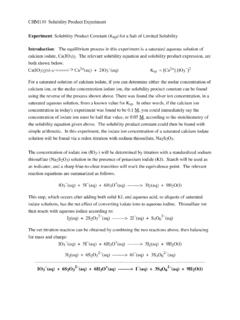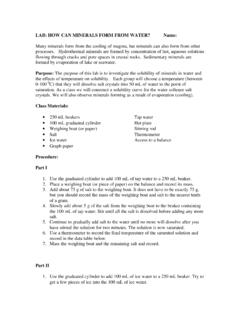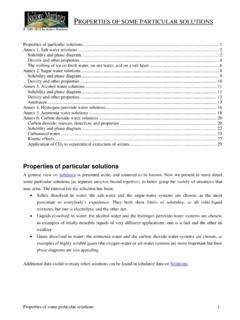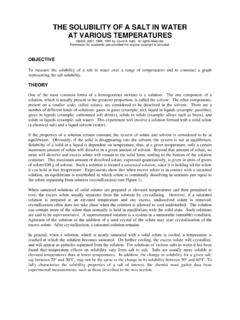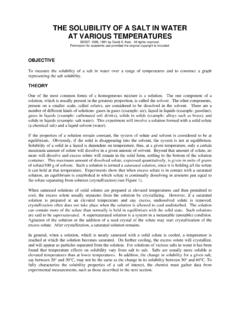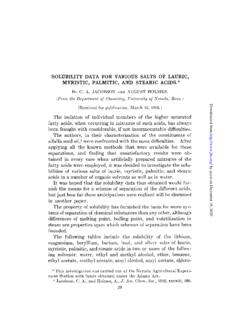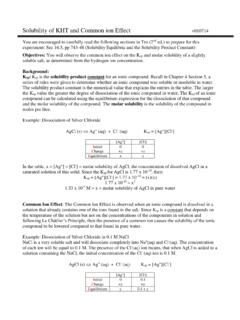Transcription of STUDIES OF THE SOLUBILITY OF CALCIUM SALTS. - jbc.org
1 STUDIES OF THE SOLUBILITY OF CALCIUM SALTS. III. THE SOLUBlLITY OF CALCIUM CARBONATE AND TERTIARY. CALCIUM PHOSPHATE UNDER VARIOUS CONDITIONS. BY JULIUS SENDROY, JR.,* AND A. BAIRD HASTINGS. (From the Hospital of The Rockefeller Institute for Medical Research, New York.). (Received for publication, September 2, 1926.). It is well ,known that the two primary bone salts are CaC03. and Ca,(PO&, with more or less CaHP04. Probably the best Downloaded from by guest on November 27, 2018. available figures for the amount of CaC03 in bone are those of Goto (1918) whose analyses for CALCIUM and for carbonate by an improved method of Van Slyke (1918) give values in bone of normal rabbits of per cent CALCIUM and per cent CO8.)
2 (carbonate per cent). The figures for phosphate cannot be used because they include the organic phosphate of the marrow lipoids. CALCIUM carbonate would evidently be per cent, and tertiary CALCIUM phosphate, if all of the remaining CALCIUM be assumed in that form, would be per cent, giving a CaC03 : Ca3(PO& ratio of 31 per cent : 69 per cent. Although somecarbonate may have been present as the sodium salt , this is nevertheless a decidedly higher figure than the 15 : 85 per cent ratio commonly quoted for the bone salts, and places somewhat more stress on the importance of CALCIUM carbonate in CALCIUM metabolism.)
3 In the absence of evidence as to the presence of CaHPOd in bone, the study of the SOLUBILITY of the CALCIUM salts of bone was confined to CaC03 and Cas(PO&. Having obtained the results of the preceding paper for tricalcium phosphate under various conditions, and in view of the results of Holt, La Mer, and Chown (1925 a, b) which appeared while the study of CALCIUM carbonate * This paper is part of a thesis submitted by Julius Sendroy, Jr., in partial fulfilment of the requirements for the degree of Doctor of Philosophy in the Faculty of Pure Science, Columbia University.)
4 797. 798 SOLUBILITY of CaC03 and Ca3(POJ2. equilibria was in progress, it seemed desirable, since bone contains solid CaC03 and Ca3(P0&, to the equilibrium conditions for salt solutions and serum in the presence of these two solids. A priori, one would expect that equilibrium for both, that is a con- dition of saturation for both salts, would only be obtained in the presence of the two salts as saturating bodies. The experiments performed clearly indicate, with a few exceptions that seem fairly well capable of explanation, that such is the case.))
5 In accordance with the theoretical considerations given, for any Downloaded from by guest on November 27, 2018. salt solution in equilibrium with solid CaC03 and Ca3(P0&, the following equations hold : (1) a&++ x cos= = (2) (aca,+)3 X (apo4~)2 = KS.*. Ca3(PO&. Eliminating c+*+, one obtains K CaC03. (3) -= ffcoa=. caPoF) * Lp. (CWPOJ *) f For any solution of fixed ionic strength, (4) - [COs'l = K'B.*. COCOS. [P04+ K' (Ca,(PO&)*. or expressed in terms of negative logarithms pCOa' _ 27 = PKt*.p. CaC03 - pK'wL ypoJ2. (5). This equation shows that in any solution in equilibrium with both solid salts, CaC03 and Ca,(PO&, there will be a definite ratio between the COs= ion concentration and the POP ion concentra- tion; and one and only one ratio is compatible with equilibrium for both salts.)))]]
6 Furthermore, fixing either the [C03=] or the [P04=] fixes the [Ca++] which can be in equilibrium with the solid phase at that ionic strength. One may fix the system in any one of a variety of ways. We have centered our attention on fixing the paH+ wit,hin physio- logical limits by adjusting the CO2 tension. This has fixed the [COs=] which in turn fixed the [Ca++]. Where phosphate was also J. Sendroy, Jr., and A. B. Hastings 799. present, there must have been a further adjustment until the KO3'1. ratio of --2 satisfied the requirements of equilibrium.
7 [Po,=]x EXPERIMENTAL RESULTS. E$ect of Vcwying Ionic Strength on Apparent or Stoichiometric SOLUBILITY Products of C&OS and Ca3(P04)2. salt solutions were made up as outlined in the previous papers. Downloaded from by guest on November 27, 2018. Each solution contained CALCIUM , phosphate, and bicarbonate with 1 per cent of volume added in weight as CaCOs and Ca3(PO&. Eight different solutions were prepared, the ionic strength being increased in the second and third by NaHC03, after which the NaHC03 concentration was kept constant and the ionic strength increased with NaCl.)
8 The experiment was repeated (Series A) by preparing eight new solutions. CALCIUM was analyzed in 5 cc. samples and titrated with N/200 KMn04. The results given by electrometric pan+ determinations were all so unsatisfactory, apparently due to the electrode LLpoisoning . encountered by Holt, La Mer, and Chown, that the pan+ was calculated on the basis of total COZ and COz tension analyses as outlined in the section on calculations. The analytical determinations of CALCIUM gave the value of [Ca++] immediately, since the difficultly soluble salts are assumed to be completely ionized.
9 For each of the sixteen solutions, pan+ was calculated by equation (50), Paper I, by using the proper values for ffcol in accordance with equation (48). From, the total [CO,], values for [CO,=] and [HC03-] were obtained by equations (32) and (33), respectively. From the total [PO,]. values for [POqE] and [HPOd=] were obtained by equations (16). and (15), Paper II, respectively. Tables I and II contain the data obtained in these experiments. They have been plotted in Figs. 1 and 2 with pK',,,,CaCOa and pK',,,,Ca3(P0& as ordinates, and 4; as absciss%.)
10 The equation of the line through these points was obtained in the following manner. In order to calculate pK',,,, of CaC03 and Ca3(P0& accurately, it was necessary to employ the stoichiometric values for the two dissociation constants of carbonic acid, and the stoichiometric TABLE I. Variation of pK',.,. CaCOa at 58 in salt Solutions of Varying Ionic Strength. pK = - ; - - GO, 7 - T. z- 0 0 Q. u, $. 2x. c;; . g:aP 0 z2. P 2. ~-- ' , 2 2A 83 4 4A 5 5A 6 6A 7 7A ~2. 8 8A -- Downloaded from by guest on November 27, 2018. J. Sendroy, Jr., and A.)


